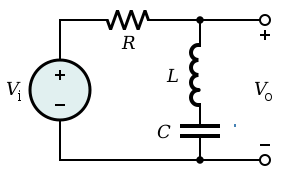What Does A Notch Filter Do
In bespeak processing, a band-stop filter or band-rejection filter is a filter that passes most frequencies unaltered, simply attenuates those in a specific range to very low levels.[1] It is the opposite of a band-pass filter. A notch filter is a ring-cease filter with a narrow stopband (loftier Q factor).
Narrow notch filters (optical) are used in Raman spectroscopy, alive sound reproduction (public address systems, or PA systems) and in musical instrument amplifiers (especially amplifiers or preamplifiers for acoustic instruments such as audio-visual guitar, mandolin, bass instrument amplifier, etc.) to reduce or preclude audio feedback, while having trivial noticeable upshot on the remainder of the frequency spectrum (electronic or software filters). Other names include "ring limit filter", "T-notch filter", "band-elimination filter", and "ring-turn down filter".
Typically, the width of the stopband is i to 2 decades (that is, the highest frequency attenuated is x to 100 times the lowest frequency attenuated). However, in the audio ring, a notch filter has high and depression frequencies that may be but semitones apart.

Generic electrical schematic of a simple band-stop filter
Mathematical description [edit]
Band-stop filter can be represented as a combination of low-pass and high-pass filters if the bandwidth is broad enough that the two filters practice not collaborate besides much. A more general approach is to blueprint equally a low-pass prototype filter which can then be transformed into a bandstop. The elementary notch filter shown can be directly analysed. The transfer function is,
Here is zero circular frequency and is the pole circular frequency. Zero frequency is the cutoff frequency and sets the type of the notch filter: standard notch when , low-pass notch ( ) and high-pass notch ( ) filters. denotes the Q-factor.[2]
For standard notch filter the formulation can be rewritten every bit
where is the central rejected frequency and is the width of the rejected band.
Examples [edit]
In the audio domain [edit]
- Anti-hum filter
For countries using 60 Hz ability lines:
- low frequency: 59 Hz,
- center frequency: sixty Hz,
- loftier frequency: 61 Hz.
This means that the filter passes all frequencies, except for the range of 59–61 Hz. This would be used to filter out the mains hum from the sixty Hz power line, though its higher harmonics could all the same exist nowadays.
For countries where power transmission is at 50 Hz, the filter would accept a 49–51 Hz range.
In the radio-frequency (RF) domain [edit]
- Non-linearities of power amplifiers
When measuring the non-linearities of power amplifiers, a very narrow notch filter can exist very useful to avoid the carrier frequency. Utilise of the filter may ensure that the maximum input power of a spectrum analyser used to detect spurious content will not be exceeded.
- Wave trap
A notch filter, commonly a simple LC excursion, is used to remove a specific interfering frequency. This is a technique used with radio receivers that are so close to a transmitter that it swamps all other signals. The moving ridge trap is used to remove or greatly reduce the signal from the nearby transmitter.[3]
- Software-defined radio
Most affordable software-divers radios (SDR) on the market place today endure from limited dynamic and operating ranges. In other words, in real-world operating environments, a SDR can hands be saturated by a strong point. In item FM broadcast signals are very strong and well-nigh everywhere. These signals can forestall a SDR from processing other weak signals. FM notch filters are very useful for SDR applications and accept increased in their popularity.
Optical filtering (wavelength option) [edit]
In optics, there are several methods of filtering selected wavelengths from a source or to a detector. They rely on scattering or destructive interference.
Filtering by scattering and diffraction [edit]
A diffraction grating[4] or a dispersive prism may exist used to selectively redirect selected wavelengths of calorie-free within an optical system.
In the case of transmission gratings and prisms, polychromatic light that passes through the object will exist redirected co-ordinate to wavelength. A slit may then be used to select wavelengths that are desired. A reflective grating may also exist utilized for the same purpose, though in this case light is reflected rather than transmitted. Filters of this design may be high-pass, band-pass, or depression-pass, depending on system configuration.
Filtering past interference [edit]
When using optics with real materials, lite will be attenuated at various wavelengths through interference with the medium through which the light traversed. In this sense, textile selection may be utilized to selectively filter light according to the wavelengths that are minimally adulterate. To some extent, all existent optical systems will suffer from this phenomenon.
Alternatively, information technology is also possible to use an aquiver reflecting surface to cause destructive interference with reflected light along a unmarried optical path. This principle is the basis for a Michelson interferometer.
See also [edit]
- Parametric blaster
References [edit]
- ^ "Band-stop filter", Federal Standard 1037C, accessed 14 May 2018.
- ^ "Chapter 8: Analog Filters". Basic Linear Pattern. U.s.: Analog Devices Inc. 2006.
- ^ Carr, Joseph J. (2001). The technician's radio receiver handbook: Wireless and telecommunication engineering, p. 282. Newnes. ISBN 0-7506-7319-2.
- ^ Terracciano, Anthony (2018). "Chancy Gas Detection Sensor Using Broadband Lite-Emitting Diode-Based Assimilation Spectroscopy for Space Applications". New Space. 6 (1): 28–36. doi:x.1089/space.2017.0044.
What Does A Notch Filter Do,
Source: https://en.wikipedia.org/wiki/Band-stop_filter
Posted by: thiesputed1978.blogspot.com












0 Response to "What Does A Notch Filter Do"
Post a Comment